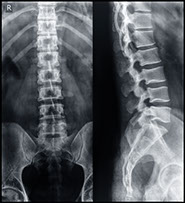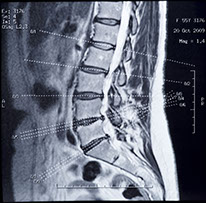


The diagnostic process...
There are many versions of the back pain story. How it began, how severe the pain was, what caused it to get worse or better. At some point, there comes a time when you know you must do something more to get help with this pain. Suggestions from friends and family can be helpful but it is confusing to know where to start.
It is important that you choose a healthcare team in which you have confidence. A teamwork approach is the most effective in resolving or managing back pain. Most back pain problems have multiple contributing factors that respond best to different types of treatment. Treatment can be as simple as medication and a lifestyle adjustment to possible surgery and months of rehab. The confidence level that you have in the advice that you get from your team will influence how likely you are to follow through with treatment recommendations to achieve the best results.

Your team members can be your physician, physicians assistant, nurse practioner, surgeon, chiropractor, physical therapist. Other team members could include a nutritionist, counselor, athletic trainer, massage therapist, acupuncturist, and ergonomic specialist. Each specialist brings an array of valuable tools that can help resolve your problem.
Physicians, Physicians assistants, and nurse practioners usually function as a central manager of care. They begin with a review of all your body systems and medical history. They gather the details of your pain history, and after examining you, they decide where to start. They might need more diagnostic tests or lab work to complete an initial diagnosis. They may start you on different medications or send you to a specialist to advise you on how to care for and protect your back.
Some of the more common tests you might encounter are Xrays, and MRIs. Xrays look at the bones. They screen for fractures, bony changes or deformities. How the bony alignment does or doesn’t change with motion is evaluated with dynamic xrays. The MRI visualizes a variety of different soft tissues such as the nervous system, discs, ligaments and muscles.
X RAY
MRI


Today’s technology is so good that we have to be careful with seeing false positives. There have been many disc bulges and other pathologies revealed in testing that aren’t actually the source of the pain. Your team members will correlate your test findings with your clinical presentation and then formulate a plan for your best interests.
If your pain levels don’t respond to different treatments and the test results reveal a serious disc herniation or stenosis, then you may have to talk with a surgeon to see if a surgery is needed. Surgery is highly recommended when the nerve is being damaged and the nerve function is compromised. Surgery is helpful when the damage is so great that the spine is unstable and unlikely to heal despite treatment.
The contents of BackPainExplained web site including the text, graphics, images, and other material are for informational purposes only. The content of this web site is not intended to be a substitute for professional medical advice, diagnosis, or treatment. Always seek advice of your physician or other qualified health professional with questions you may have regarding a medical condition. Do not delay seeking medical advice or disregard professional treatment advice because of something that you have read on BackPainExplained.
Call your physician or 911 if you think that you have a medical emergency. Reliance on any information within BackPainExplained web site is solely at your own risk.